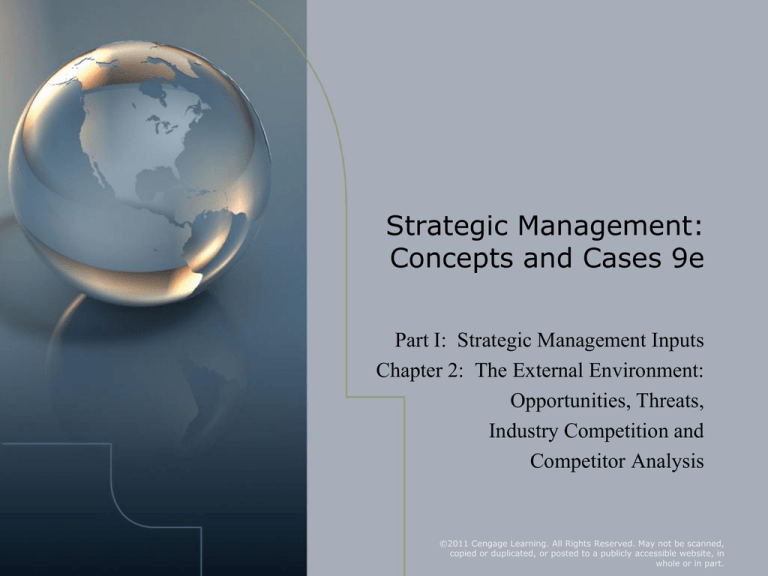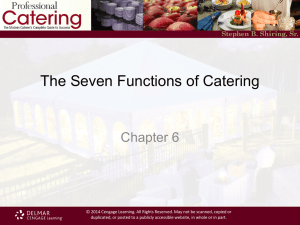
Strategic Management:
Concepts and Cases 9e
Part I: Strategic Management Inputs
Chapter 2: The External Environment:
Opportunities, Threats,
Industry Competition and
Competitor Analysis
©2011 Cengage Learning. All Rights Reserved. May not be scanned,
copied or duplicated, or posted to a publicly accessible website, in
whole or in part.
Chapter 2: The External Environment:
Opportunities, Threats, Industry Competition
and Competitor Analysis
• Overview:
– General and industry environment
– External environment analysis process activities
– General environment segments
– Porter’s 5 Competitive Forces
– Strategic groups: Definition and influence
– Competitor Analysis: Intelligence and ethics
©2011 Cengage Learning. All Rights Reserved. May not be scanned, copied or duplicated, or posted to a publicly accessible website, in whole or in part.
External Environment:
General, Industry and Competitor
• Three External Environments include:
– General
– Industry
– Competitor
©2011 Cengage Learning. All Rights Reserved. May not be scanned, copied or duplicated, or posted to a publicly accessible website, in whole or in part.
External Environment:
General, Industry and Competitor (Cont’d)
• The General Environment
– The broader society dimensions that influence an industry and the
firms within it
– Grouped into 7 dimensions OR ‘environmental segments’
• Industry Environment
– Set of factors directly influencing
• A firm’s competitive actions/responses
• Relates to Porter’s 5 Forces
• Competitor analysis: gather and interpret competitor information
• Competitor Environment
– Gives details about
• A firm’s direct and indirect competitors
• The competitive dynamics expected to impact a firm's efforts to generate
above-average returns
©2011 Cengage Learning. All Rights Reserved. May not be scanned, copied or duplicated, or posted to a publicly accessible website, in whole or in part.
External Environment Analysis
• Opportunity
– General environment condition that, if exploited, helps a
company achieve strategic competitiveness
• Threat
– General environment condition that may hinder a
company's efforts to achieve strategic competitiveness
• 4 components of External Environment Analysis
– Scanning
– Monitoring
– Forecasting
– Assessing
©2011 Cengage Learning. All Rights Reserved. May not be scanned, copied or duplicated, or posted to a publicly accessible website, in whole or in part.
Industry Environment Analysis
• Industry
– Definition: Group of firms producing products that are close substitutes
– Industry environment, in comparison to the general environment, has
more direct effect of firm’s
• Strategic competitiveness and
• Above-average returns
– Intensity of industry competition and industry’s profit potential are a
function of 5 forces
©2011 Cengage Learning. All Rights Reserved. May not be scanned, copied or duplicated, or posted to a publicly accessible website, in whole or in part.
Industry Environment Analysis (Cont’d)
• Porter’s 5 Forces
– 1/5: New entrants
• Can threaten market share of existing competitors
• May bring additional production capacity
• Function of two factors
– 1: Barriers to entry
» Economies of scale
» Product differentiation
» Capital requirements
» Switching costs
» Access to distribution channels
» Cost disadvantages independent of scale
» Gov’t policy
– 2: Expected retaliation
– 2/5: Threat of substitute products
• Goods or services outside of given industry perform same or similar functions
at a competitive price (i.e., plastic has replaced steel in many applications)
©2011 Cengage Learning. All Rights Reserved. May not be scanned, copied or duplicated, or posted to a publicly accessible website, in whole or in part.
Industry Environment Analysis (Cont’d)
• Porter’s 5 Forces
– 3/5: Bargaining power of suppliers
• They are powerful when …
– 1.
– 2.
– 3.
– 4.
– 5.
– 6.
Few large companies and more concentrated
No substitutes
Industry firms not significant customer to supplier
Supplier’s goods are critical to buyer’s success
High switching costs due to effectiveness of supplier’s products
Threat of forward integration
– 4/5: Bargaining power of buyers
• They are powerful when …
– 1. Purchase large portion of industry’s total output
– 2. Product sales accounts for significant seller annual revenue
– 3. Low switching costs (to other industry product)
– 4. Industry products are undifferentiated or standardized and
threat of backward integration
©2011 Cengage Learning. All Rights Reserved. May not be scanned, copied or duplicated, or posted to a publicly accessible website, in whole or in part.
Industry Environment Analysis (Cont’d)
• Porter’s 5 Forces
– 5/5: Intensity of Rivalry Among Competitors
• Numerous or equally balanced competitors
• Slow industry growth
• High fixed costs or high storage costs
• Lack of differentiation or low switching costs
• High strategic stakes
• High exit barriers
©2011 Cengage Learning. All Rights Reserved. May not be scanned, copied or duplicated, or posted to a publicly accessible website, in whole or in part.
Strategic Groups
• Strategic Groups
– Set of firms emphasizing similar strategic dimensions to
use a similar strategy
– Implications
• Because firms within a group compete (offer similar products)
rivalry can be intense – the greater the rivalry the greater the
threat to each firm’s profitability
• Strengths of the 5 forces differs across strategic groups
• The closer the strategic groups, in terms of strategy, the
greater the likelihood of rivalry
©2011 Cengage Learning. All Rights Reserved. May not be scanned, copied or duplicated, or posted to a publicly accessible website, in whole or in part.
Competitor Analysis
• Competitor analysis and organization response:
– What drives competitors
• Shown by organization's future objectives
– What the competitor is doing and can do
• Revealed in organization's current strategy
– What the competitor believes about the industry
• Shown in organization's assumptions
– What the competitor’s capabilities are
• Shown by organization's strengths and weaknesses
©2011 Cengage Learning. All Rights Reserved. May not be scanned, copied or duplicated, or posted to a publicly accessible website, in whole or in part.
Competitor Analysis Components
©2011 Cengage Learning. All Rights Reserved. May not be scanned, copied or duplicated, or posted to a publicly accessible website, in whole or in part.
Competitor Analysis (Cont’d)
• Competitor intelligence
– Set of data and information the firm gathers to better understand
and anticipate competitors' objectives, strategies, assumptions,
and capabilities
• Follow ethical practices when gathering competitor
intelligence
– Obtain public information
– Attend trade fairs and shows and collect brochures, view exhibits,
listen to their discussions
• Some practices may be legal, but unethical
• Unethical tactics can include
–
–
–
–
Blackmail
Trespassing
Eavesdropping
Stealing drawings, samples or documents
©2011 Cengage Learning. All Rights Reserved. May not be scanned, copied or duplicated, or posted to a publicly accessible website, in whole or in part.







